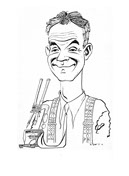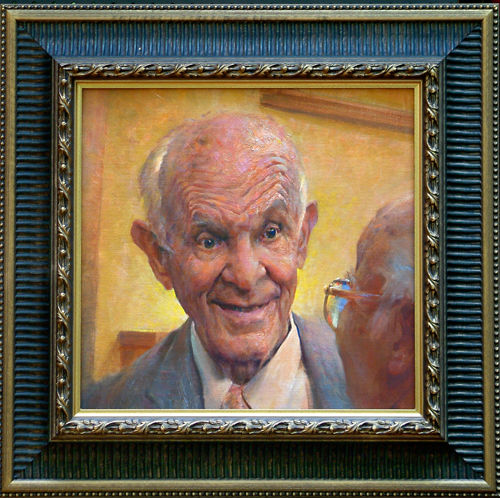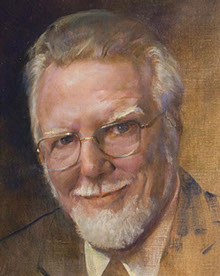
 On the left is an oil portrait of Gordon Hadley, MD, emeritus dean of the School of Medicine, Loma Linda University, at age 83, that I painted in 2003. To the right is a caricature I did of him 58 years earlier, in 1954, when he was a young pathologist-teacher aged 33, and I his resident aged 25. In the 58-year period he progressed from caricature rendered in sable brush a la Milton Caniff with a hint of Al Hirschfeld, to full if not-quite formal oil portrait, more like Norman Rockwell than Rembrandt, duly framed. My model for caricature and portrait, Dean Hadley is the model octogenarian to introduce my collection of essays about Octogenariancy and beyond.
On the left is an oil portrait of Gordon Hadley, MD, emeritus dean of the School of Medicine, Loma Linda University, at age 83, that I painted in 2003. To the right is a caricature I did of him 58 years earlier, in 1954, when he was a young pathologist-teacher aged 33, and I his resident aged 25. In the 58-year period he progressed from caricature rendered in sable brush a la Milton Caniff with a hint of Al Hirschfeld, to full if not-quite formal oil portrait, more like Norman Rockwell than Rembrandt, duly framed. My model for caricature and portrait, Dean Hadley is the model octogenarian to introduce my collection of essays about Octogenariancy and beyond.
Deans leave their marks, and Dean Hadley left one for cordiality and remembering names no dean can match. Over the decades he knew the names of every student in every class, students graduating from studenthood to personal friendship and known by name forever. A highlight of an annual Alumni Postgraduate Convention was when, in the throng at intermission between seminars or at the Alumni Banquet, he suddenly fixed upon your face and came trotting straight at you, shouting before he got within ten feet, “Wes! It’s so great seeing you again!” – while spotting somebody else to race away to.
So in his portrait he’s not garbed in gown and deanish. He’s greeting an old student in the same wide-eyed, startled, grinning way he always had greeted him over the years.
Just recently Dean Hadley died (June 2012), at age 91, graduating to nonagenariancy, with all the privileges and honors thereunto pertaining. I painted him when he was 83, And now I’m 89, one year shy of nonagenariancy. I expect to make it to 91, and then, like him, fade.
Dr. Hadley was famous for his special brand of cordiality, which, of all his many praise-worthy qualities, is what I found so paintable and tried to catch in his portrait. By the way, this portrait is one of over 50 commissioned by the LLUSOM Alumni Association and Administration in 2003, published as a hardback limited edition by the Alumni Association, edited by R. Herber, MD, and displayed online at the (click here) Alumni web site (Hadley's caricature, and many others of the old "CME" are also posted on that site.)
As presented visually in the portrait of Dean Hadley, Octogenariancy is what this batch of essays is about. Though his wide eyes, forehead on alert, and attentive grin are ageless, his senile freckles (lentigo senilis, as we pathologists would say) and larger ears, among other things better depicted than described, show that Dr. Hadley in the portrait is not the 30-some-year-old in my caricature. Likewise these essays , in tone and especially subject and content, are not hardly as I would have written them 58 years ago. I couldn't have written them back then. Lentigos are always and without ado Photoshopped out of the formal photographs any institution publishes, which says something about institutions, about formal photographs, and thus something about my portraits (and my essays), in which the warts are still there (and says why I don't do commissions). Read on if you want Octogenariancy in words -- lentigos, hearing aids, and all.
“Octogenariancy” is a category you won’t find in other collections of essays, web or paper. It wouldn’t have been on my web site 20 years ago. But now that I’m an octogenarian-almost-ready-to-graduate myself, octogenariancy has become suddenly not only relevant but downright intriguing, as intriguing as, say, the Kreb’s Cycle or sex was 30 years ago. And nowadays I’m somehow writing a lot about religion, more than I would have 20 years ago, and rather than filing those essays under their own heading, “Religion,” as seems logical and as I would have 20 years ago had I written about religion at all back then, they’re filed under “Octogenariancy.” Which is really where they belong, for me as an octogenarian. If sex is enthralling in youth, the meaning of it all takes over in old age. It has for me.
But if “Octogenariancy” is stuffed with religious essays, those essays, like the category enfolding them, aren’t like you’d find elsewhere, being not very pious or devotional, perhaps outrageously so. I may have no choice but to conform to being octogenarian, and won’t fight it, and thus won’t fight God, but in style and perspective I’m a nonconformist to the end. So start here.
BTW, it's appropriate that this README began with a portrait, one that I painted. I'm also an artist, perhaps mainly an artist, although also a physician (more people know me as that than as an artist), and writer (who knows that?) I recently held a retrospective exhibition entitled "My 87-year Life in Art," and belabored writing an "an Octogenarian Artist's Statement." Lot's of octogenarian looking back, as relevant to this section as to my art, where it's posted. Click here

updated April 13, 2018

